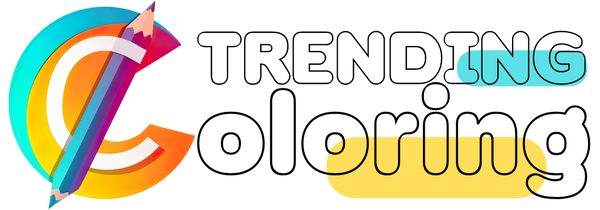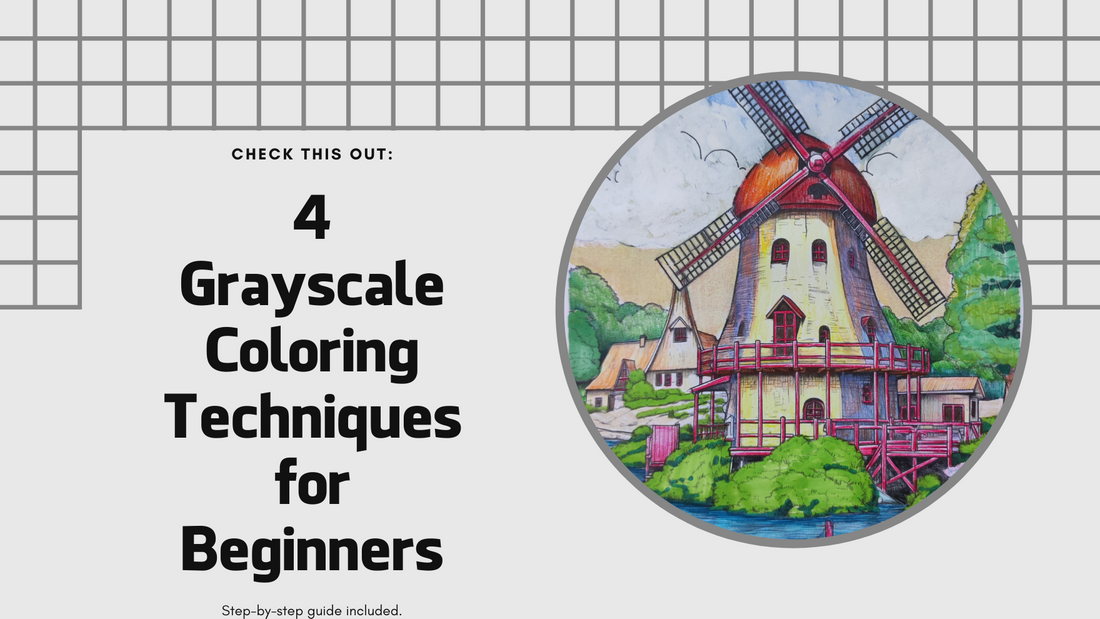Grayscale coloring is an artistic technique that involves adding color to black and white images or drawings. It's a popular hobby among artists of all skill levels, from beginners to professionals. In this blog post, we'll explore four grayscale coloring techniques that are perfect for beginners to try out.
1. Pencil Coloring

Basic Pencil Techniques
Pencil coloring is one of the most basic and versatile techniques for grayscale coloring. Here are some basic pencil techniques to get you started:
- Layering: Start with light layers of color and gradually build up the intensity by adding more layers. This technique allows for smoother transitions and more natural-looking color gradients.
- Blending: Use a blending stump or tortillon to blend colors together and create seamless transitions. Blending is essential for creating realistic shading and highlights.
- Hatching: Use short, parallel lines to create the illusion of tone and texture. This technique is particularly useful for creating the appearance of hair, fur, or fabric.
- Cross-hatching: Use intersecting lines to create a denser and darker tone. This technique is often used to create shadows or add depth to an image.
Advanced Pencil Techniques
As you become more comfortable with pencil coloring, you can try some advanced techniques:
- Burnishing: Use a colorless blender pencil or a paper stump to apply pressure to the colored areas, creating a smooth and polished look. Burnishing is great for creating a sense of realism and depth.
- Stippling: Use small, closely spaced dots to create a sense of texture and tone. This technique is often used for creating skin tones or adding texture to fabrics.
- Scumbling: Lightly layer colors over each other to create a hazy, atmospheric effect. This technique is useful for creating a sense of depth and distance in landscapes or cityscapes.
2. Marker Coloring
Basic Marker Techniques
Markers are another popular tool for grayscale coloring. Here are some basic marker techniques to try:
- Layering: Start with lighter colors and gradually build up the intensity by adding darker layers. This technique is similar to layering with pencils, but the colors tend to blend more seamlessly with markers.
- Blending: Use a colorless blender marker or a colorless blending solution to blend colors together. This technique creates smooth transitions and gradients, and is particularly useful for creating realistic skin tones or blending colors in a landscape.
- Hatching: Use parallel lines of color to create a sense of tone and texture, similar to pencil hatching.
Advanced Marker Techniques
As you gain more experience with markers, you can try some advanced techniques:
- Alcohol Markers: Alcohol-based markers are a popular choice for grayscale coloring due to their vibrant colors and blendability. They can be used for many of the same techniques as traditional markers, but they also offer some unique advantages, such as the ability to blend colors directly on the paper using a colorless blender marker.
- Stippling: Use small, closely spaced dots of color to create a sense of texture and tone, similar to pencil stippling. This technique is particularly useful for creating realistic skin tones or adding texture to fabrics.
- Dry Brushing: Use a dry brush to lightly apply color to the paper, creating a textured and somewhat rough effect. This technique is great for creating a sense of depth and realism in landscapes or adding texture to surfaces like stone or wood.
3. Colored Pencil Coloring
Basic Colored Pencil Techniques
Colored pencils are a popular choice for grayscale coloring due to their versatility and ability to create rich, vibrant colors. Here are some basic colored pencil techniques to try:
- Layering: Start with lighter colors and gradually build up the intensity by adding darker layers. This technique allows for smooth transitions and natural-looking color gradients.
- Blending: Use a colorless blender pencil or a paper stump to blend colors together, creating seamless transitions and realistic shading.
- Hatching: Use short, parallel lines of color to create a sense of tone and texture, similar to pencil hatching.
Advanced Colored Pencil Techniques
As you become more comfortable with colored pencils, you can try some advanced techniques:
- Burnishing: Use a colorless blender pencil or a paper stump to apply pressure to the colored areas, creating a smooth and polished look. Burnishing is great for creating a sense of realism and depth.
- Stippling: Use small, closely spaced dots of color to create a sense of texture and tone, similar to pencil stippling. This technique is particularly useful for creating realistic skin tones or adding texture to fabrics.
- Scumbling: Lightly layer colors over each other to create a hazy, atmospheric effect. This technique is useful for creating a sense of depth and distance in landscapes or cityscapes.
4. Watercolor Coloring
Basic Watercolor Techniques
Watercolor is a versatile medium that can be used for grayscale coloring, allowing for a range of techniques and effects. Here are some basic watercolor techniques to try:
- Layering: Start with lighter colors and gradually build up the intensity by adding darker layers. This technique allows for smooth transitions and natural-looking color gradients.
- Wet-on-Wet: Apply watercolor to wet paper, allowing the colors to blend and spread naturally. This technique creates soft, blended effects and is great for creating a sense of atmosphere or distance in landscapes.
- Dry Brushing: Use a dry brush to lightly apply watercolor to the paper, creating a textured and somewhat rough effect. This technique is great for creating a sense of depth and realism in landscapes or adding texture to surfaces like stone or wood.
Advanced Watercolor Techniques
As you gain more experience with watercolor, you can try some advanced techniques:
- Lifting: Use a clean, damp brush or a paper towel to lift color off the paper, creating highlights or adding texture. This technique is particularly useful for creating a sense of realism in landscapes or adding texture to surfaces like skin or fabric.
- Masking Fluid: Apply masking fluid to areas you want to remain white or uncolored, then paint over it with watercolor. When the masking fluid is removed, it reveals the white paper underneath, creating sharp, crisp edges or texture.
- Salt Technique: While the watercolor is still wet, sprinkle salt onto the paper. As the paint dries, the salt will create unique textures and patterns, adding interest and depth to your artwork.
Conclusion
Grayscale coloring is a rewarding hobby that can be enjoyed by beginners and experienced artists alike. By practicing these four techniques – pencil coloring, marker coloring, colored pencil coloring, and watercolor coloring – you'll develop a diverse set of skills and gain confidence in your ability to create beautiful, vibrant artwork. Remember to experiment, have fun, and don't be afraid to try new things. The more you practice, the more you'll grow as an artist.

